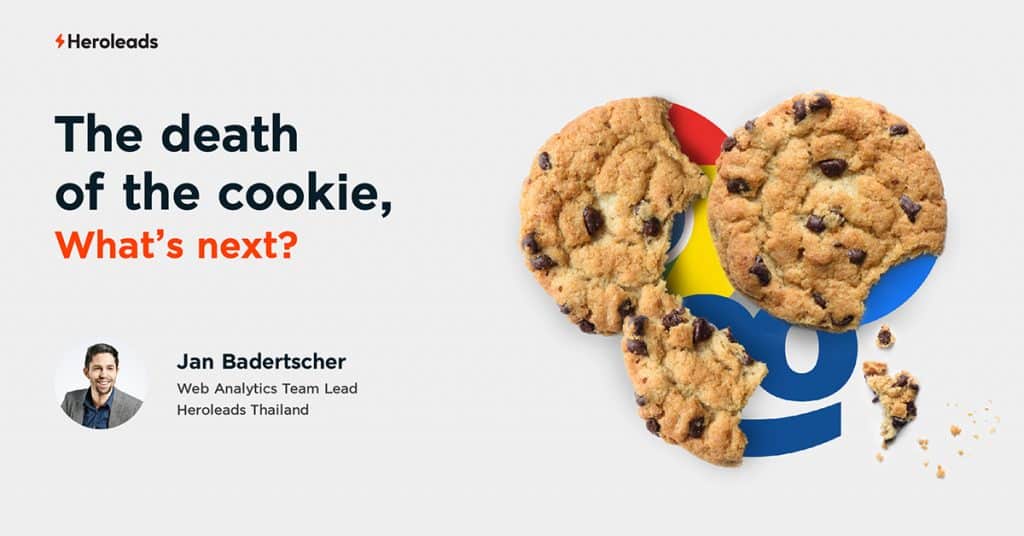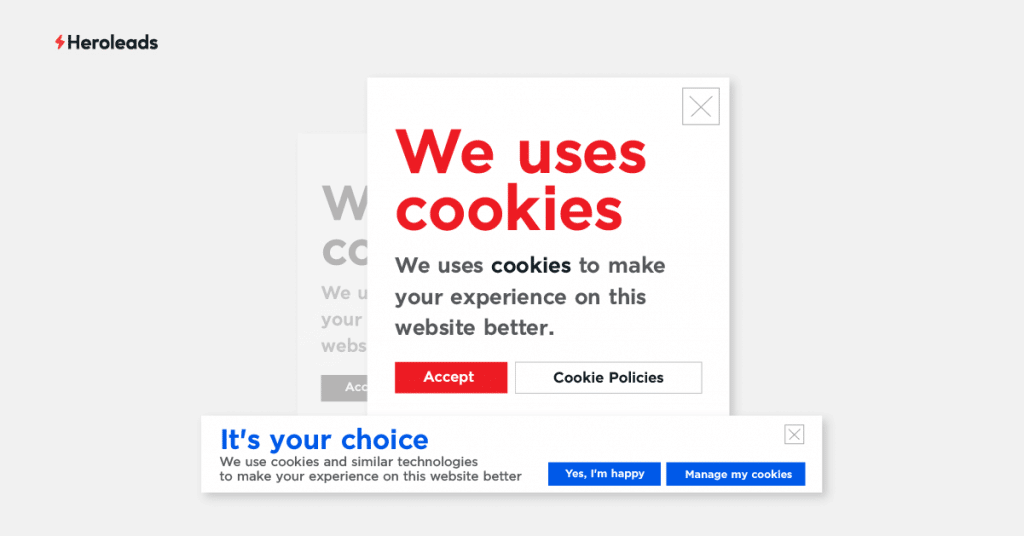The death of the cookie, what’s next?

How are cookies currently used?
1.Tracking vs. information storage
Cookies were initially created to store information in order to improve the user experience on websites. Those cookies were mainly used to store information like products added to the shopping cart, login details, language preferences and were remembered even when the user came back to the same website at a later stage.
2.First vs. third party cookies
There are mainly two types of cookies: First party cookies are created by the website a user visits, and can only be read by that website. Those are mostly used for information storage to improve user experience on a website.
Third party cookies on the other hand are created by a third party. In most cases those are AdTech companies and Ad Networks like Facebook, Google, Taboola etc. Third party cookies can be created on any website that adds code snippets (Like buttons, chat plugins, Banner Ads or login buttons) of those AdTech companies.
Those third party cookies can then be read out from the users browser when visiting any website that uses those code snippets as well.
Third party cookies were an important part of the business model of AdTech companies for more than a decade, because they enabled to track a user across several websites, which helps those companies understand the behaviour, preferences and make guesses about the users Age, Gender etc.
This in turn helps those same companies to provide advertising solutions to Brands, Companies and Agencies. The mantra was, the more and better users are understood, the more accurate the targeting. Improved targeting usually leads to lower cost or higher performance.
What changed during the last two years
1.Users care about privacy
After privacy made regular international headlines like Edward Snowden’s Wiki Leaks, Panama Papers and Facebook’s testimony before the US-Congress, privacy has become a concern of everyday people. This led to the implementation of privacy focused laws in the European Union and many parts of the world.
2.European GDPR
In April 2016 the European Union made the General Data Protection Regulation which aims to give control to individuals over their personal data. It applies to any enterprise, regardless of its location or the citizenship of its users, that is processing their personal information within the European Union.
The GDPR regulation was enforced after 25 May 2018 and had great effect across the Digital Marketing industry. By default any website doing business within the European Union is not allowed to collect any data, including loading a Google Ads, Facebook Ads or Analytics pixel, without getting consent from the user first. This led to the Cookie Popup on many websites, which has to transparently explain to the user, what information is being collected and for which purpose, allowing the user to either agree (opt in) or disagree (opt out) of the data collection.
3.Apple ITP
Apple doesn’t rely on Advertising as a business model, contrary to the two other major browser vendors like Microsoft with Bing Ads and Google with Google Ads. In 2017 Apple added a new feature called Intelligent Tracking Prevention to their Safari browser. ITP is since getting updated every few months, adapting to counter-measures of Advertising companies like Facebook and Google. This inducted a cat and mouse game between Apple and any effort trying to circumvent the measures of ITP.
Mainly ITP tries mitigating and limiting the collection of user and behavioural tracking by blocking third party cookies.
4.Google’s “end of cookie”
In May 2019 Google announced new privacy features for their Chrome browser. This included more control, choice and transparency for personalized online advertising.
An open-source Chrome extension will allow the user to see which Ad Networks, Demand-Side Platforms and Supply-Side-Platforms are involved for an Ad on the current website. There will be an open API that AdTech companies can use to present this information to users.
A new feature will give the user more control to allow or deny online targeting, measurement and attribution. This won’t impact first-party cookies like shopping cart or login cookies.
Another new feature will try to block device fingerprinting. Fingerprinting is used to circumvent Ad-Blockers and allows to track users, even when they delete or block cookies.
Gradually Google will also force websites to label their first or third party cookies clearly.
Chrome will then be able to understand the difference and allow users to block or delete third party cookies without affecting website usability.
After that Chrome will gradually implement a Privacy Sandbox, which doesn’t fully block third-party cookies, but rather tries to find a middle way between security, privacy and still satisfying advertisers with some form of user personalization and tracking in a more transparent way.
Privacy Sandbox is an open solution which allows any advertiser or AdTech network to use and get user information as well as tracking possibilities.
Starting in 2022 Google plans to fully kill the support for third party cookies and rely on their Chrome Privacy Sandbox as a middle ground between user privacy and control while still providing useful targeting and tracking for AdTech companies. The personalization will probably be only aggregated and not a 1:1 user targeting, which was common for marketers over the last decade.
Google doesn’t see the stricter privacy features implemented by Safari ITP and Firefox as a way to go forward and fears that this approach encourages companies to find workarounds and develop techniques like fingerprinting which further diminishes user privacy while providing little control to end users.
Impact on Ad Platforms
1.Google
Depending on the share of browser usage, Google Ads campaigns will either be more or less affected in the future. After most browsers completely block third party cookies, Google will rely on Chrome’s Privacy Sandbox which still provides targeting and tracking on an aggregated level. There’s little effect on users of Chrome for Google Ads Campaigns.
Users of Safari or Firefox will have a greater impact on Google Ads campaigns. Remarketing for those browsers will either not be possible or only in a very limited fashion. Display targeting will be less effective. A focus on user intent based advertising can mitigate part of this: More focus on google Search campaigns for Firefox and Safari browsers while reducing brand awareness campaigns.
2.Facebook
Facebook Ads mostly rely on a logged-in experience within their native Facebook, WhatsApp and Instagram mobile apps. Advertising and targeting on those platforms will not be negatively affected.
3.Remarketing & Criteo
Shortly after Google’s announcement to kill off the cookie by 2022 Criteo’s stock plummed. Remarketing networks like Criteo heavily depend on the use of third party cookies for their business model.
Impact on Tracking
1.Web Analytics
Tracking users on websites will be less effective, if the users stay anonymous. Without login experiences on the website, the Web Analytics reports will become more aggregated, and less focused on individual users.
Cross domain tracking will become less effective and might be forcing website owners to not link to external booking platforms or payment gateways, but rather implement those natively on their website. The UserID tracking feature will be much more important for Google Analytics setups than before.
2.Measure of conversions
Conversion tracking for Ad Platforms as well as Web Analytics tools will be impacted. A user who opts out of any tracking and prevents any form of tracking will be invisible to all marketing platforms. Depending on the browser market share and the way each browser vendor will continue to allow or block certain tracking features, the different Advertising Platforms and Web Analytics solutions will be able to track less conversions than before.
3.Attribution Modelling
Due to a shift to walled gardens and login experiences, which will help mitigate part of the difficulties, attribution modelling will suffer. A user can’t no longer be tracked easily across different marketing touch points. A shift to smaller campaigns and last-click attribution can help mitigate this issue partly.
The digital marketing gold rush is over
1.First party data
The times where every marketer can pour advertising budget into all channels and growth hack their way to a positive ROI are definitely over. It’s not longer enough to rely on data collection to optimize marketing efforts.
A shift to first party data can help build a successful marketing strategy for marketers and advertisers.
2.Focus on User & Ad experience
This means building useful experiences where users are actually willing to register on a website or app and opt in to get suggestions and promotions. This first party data can legally be used to create effective marketing and targeting.
User intent will remain a strong signal that allows Google Search campaigns to perform. While Google Display campaigns profit from a focus on creativity and contextual targeting.
Outside this walled garden approach, a focus on user feedback, reviews and surveys can help understanding visitor’s behaviour and help making decisions when Web Analytics tools provide limited insights.
3.A big win for publishers
For Display and Brand advertising a shift to contextual targeting allows for proper targeting in a post-cookie world. Networks like Taboola can shift to this technology to provide targeting to marketers and advertisers. While this will not be as sophisticated as current behavioural targeting methods, progress in advanced machine learning technologies will help improve contextual targeting capabilities.
4.You can’t ignore privacy anymore
Cookies were part of digital advertising for more than a decade. Losing them might be frightening at first, but actually provides greater independence for advertisers in the long run. Giving the user transparency and the control of his privacy gives marketers a chance to better harvest and use the advertisers first-party data and build an ecosystem around a brand, while focusing on more creativity in the ad creation process.
Welcome to the brave new marketing world.
Recent posts




